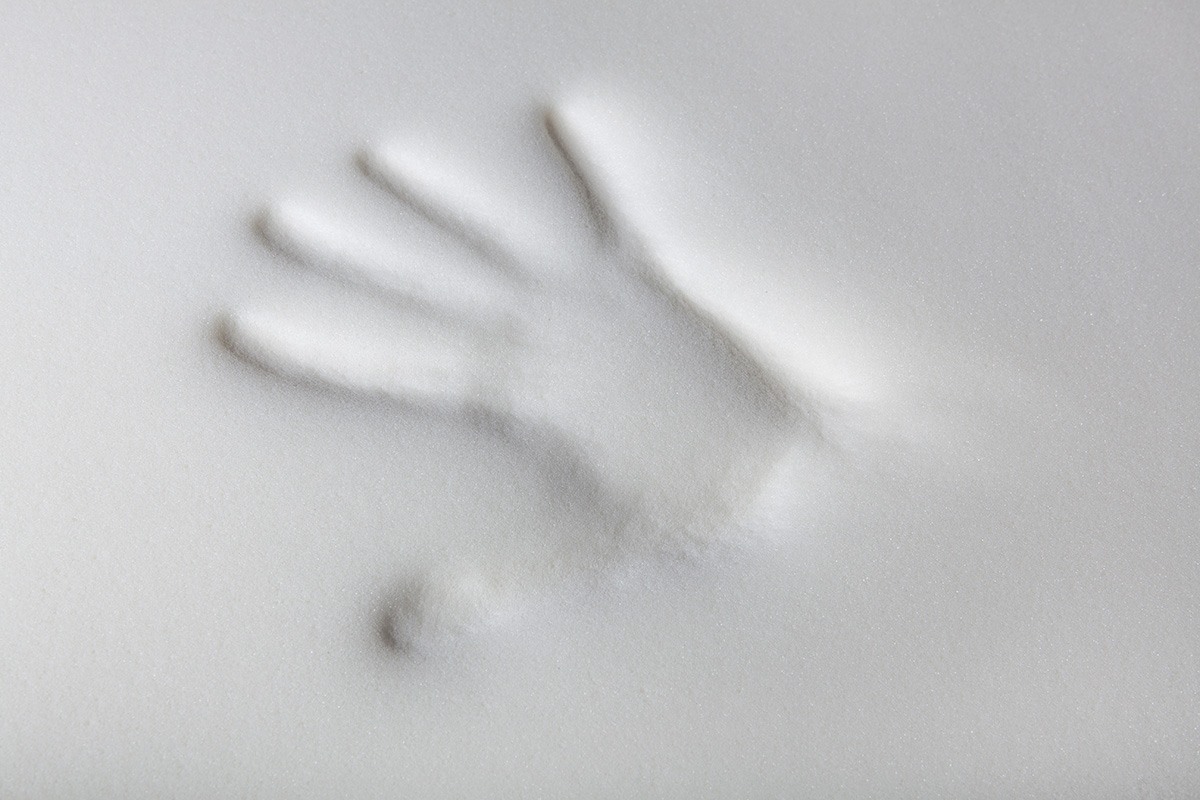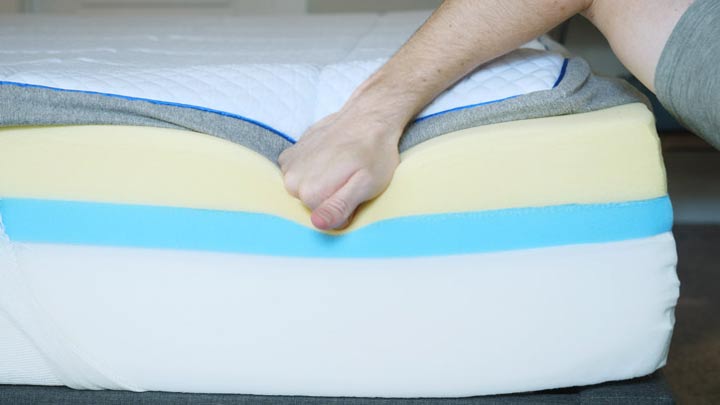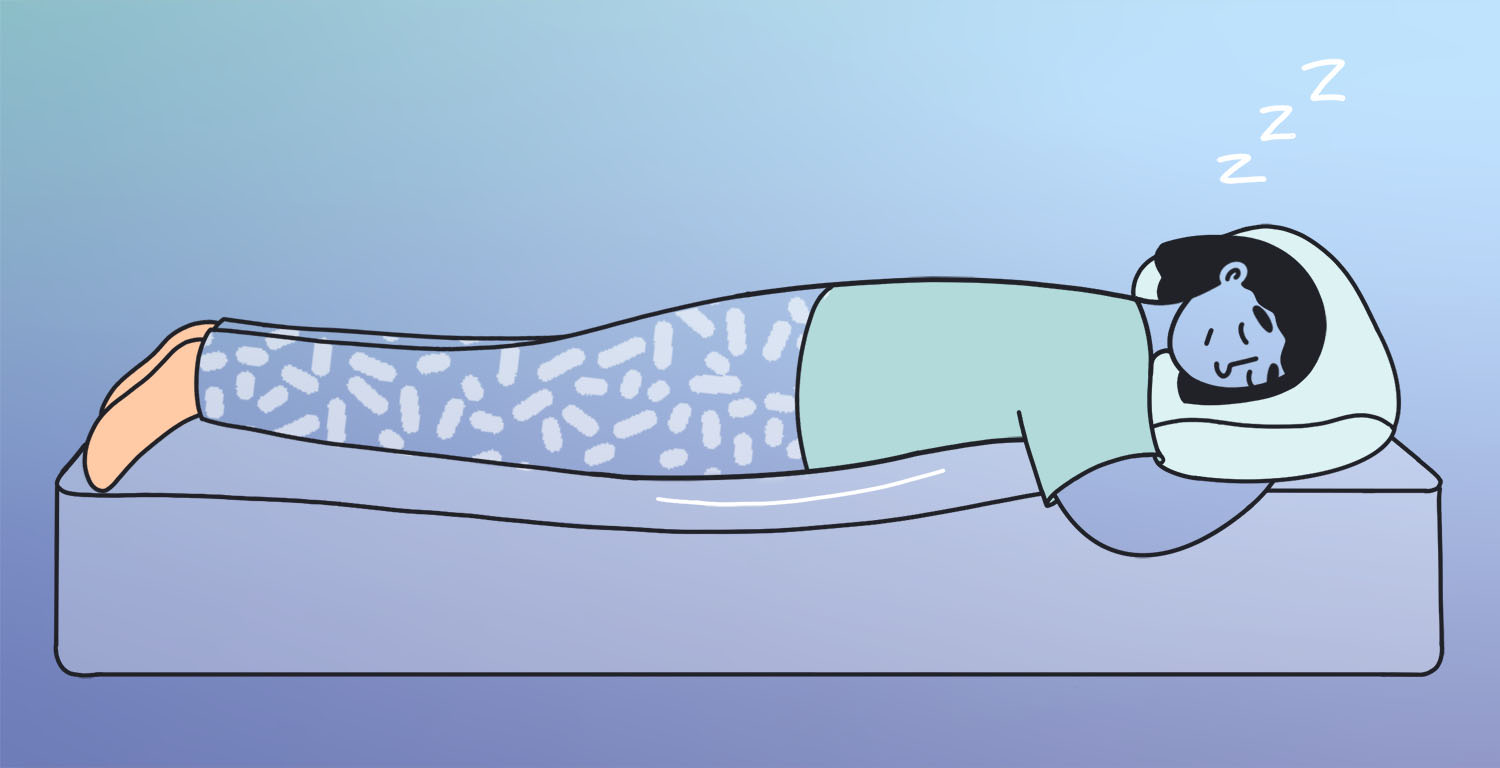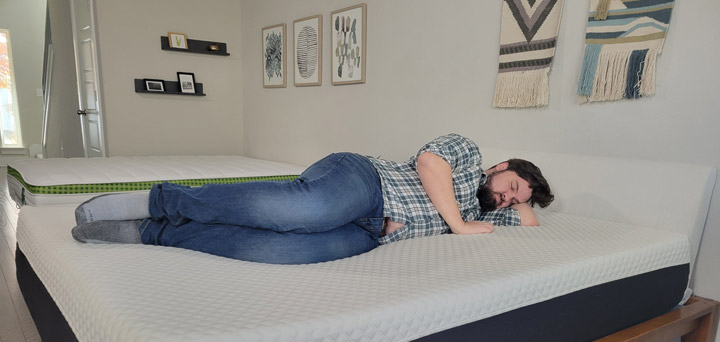When you’re looking for a new mattress, you will undoubtedly come across memory foam options. But, what is memory foam?
This guide will explain what memory foam is, how it works, and who it’s good for. Read on to learn all about memory foam!
What Is Memory Foam?
Memory foam is made up of a material called visco-elastic polyurethane foam (memory foam just sounds a lot better, right?).
Quick fun fact: Memory foam was invented in the 1960’s by researchers funded by NASA to improve the airplane seat cushion for test pilots!

It has become increasingly well known because it uniquely conforms to your body through heat and pressure. Tempur-Pedic really made this material popular with their line of memory foam mattresses that so many people own today.
Types of Memory Foam
There are a few types of memory foam you might find in a memory foam mattress:
- Standard memory foam. This type of memory foam features no extra infusions or special features and has that classic slow-moving feel.
- Fast-response memory foam. Some mattresses contain fast-response memory foam that is not as slow-moving as standard memory foam. This memory foam makes it easier for sleepers to move around and change positions.
- Open-celled memory foam. Open-celled memory foam is designed to be more breathable than standard memory foam. Its structure allows for more airflow so that it won’t trap as much heat. As we will discuss below, this is a major issue with standard memory foam.
- Gel-infused memory foam. Some memory foam features infusions designed to combat overheating. Gel, copper, and graphite are just a few of the infusions that can help lower the temperature of a memory foam mattress.
- Plant-based memory foam. For you green shoppers out there, you may want to try a mattress with plant-based memory foam. This foam is usually made from soy and is a bit more eco-friendly than standard memory foam.
Where Does Memory Foam Come From?
Memory foam, also known as Tempur or Temper Foam, was created by NASA. Yep, NASA. Researchers at NASA’s Ames Research Center invented it in 1966, while working to increase the shock absorbency of airplane seats.
According to the NASA website, aeronautical engineer Charles Yost first created “an open-cell, polymeric ‘memory’ foam material with unusual viscoelastic properties; that is, it possessed both high-energy absorption and soft characteristics.” NASA found that this new material not only offered “better impact protection” — it was also pretty comfortable.
How Does Memory Foam Work?
Memory foam is soft and absorbent, responding to heat and pressure. This means that when you lie down on a memory foam mattress or mattress topper, the material will mold to your body’s contours, evenly distributing your body weight. And once you get up again, the foam will slowly spring back into its original shape.
Memory Foam Durability
When it comes to the lifespan and durability of your memory foam mattress, you will want to take two main things into consideration: layers and foam density.
Layers
Memory foam mattresses aren’t just made up of memory foam, and for good reason. An all-memory foam mattress wouldn’t provide much support, and would cause sleepers to sink too deeply into the mattress. Instead, they typically have memory foam on the top comfort layers and then either polyfoam or springs as the support system. The number of layers and density of each layer helps determine the durability and overall quality of the mattress.

There is often a base layer followed by two or three additional layers. Every mattress is susceptible to a “weakest link,” where if one of the layers is really low-density, then the mattress will be less durable overall, even if the other layers are high-density.
The base of the mattress often sets the foundation for durability. Most likely, a thicker and higher-density base layer equates to a more durable mattress. If the base layer is polyfoam, a density of 1.8 lb or more is considered good for durability.
Density
Foam density is measured in pounds per cubic foot. Mattresses are often two to five pounds per cubic foot. Density levels typically fall into these three categories for memory foam mattresses:
- Low-Density: 3.5 lb and under.
- Medium Density: above 3.5 lb and below 5 lb/cubic ft
- High-Density: 5 lb/cubic ft or more
In many mattresses, the base layer is the thickest layer (in terms of height). The higher the density of the base layer, the more support the mattress will provide overall. Higher density means there is more foam per cubic foot within the mattress layer. This translates to higher durability and higher quality.
And yes, the mattress will most likely be more expensive. More expensive mattresses will tend to have more memory foam than other types of foam as well.
Keep in mind that density does not equal firmness when it comes to foam. However, higher density typically means more durability and more support.
Memory Foam Pros & Cons
Memory foam has its upsides, but it also has its downsides. Here are the major pros and cons of a memory foam mattress.
Pros
- Memory foam offers excellent pressure relief.
- Memory foam provides pain relief for the joints and back.
- The mattresses are a great match for side sleepers.
- Memory foam mattresses are often more affordable than other mattress types.
Cons
- Memory foam can make it more difficult to move around and change positions.
- Its chemicals can trap body heat and make you overheat at night.
- Memory foam is not as supportive as some other mattress materials.
How Does Memory Foam Compare To Other Mattress Materials?
If you’re considering memory foam, you still want to see how it stacks up against other mattress materials and mattress types. Let’s do some comparison shopping.
Memory Foam vs Latex
Latex foam is made from the sap found in rubber trees. There are a few types of natural latex, including Dunlop and Talalay, but all are naturally occurring. Latex foam differs from memory foam in that it is more natural.
Latex is also a bouncier material than memory foam. This makes it much easier to roll around and change positions on. While you might get stuck in a memory foam mattress, this is much less likely on a latex mattress.
Memory foam is known for sleeping hot, whereas latex mattresses tend to sleep cool. Latex does not contain the heat-trapping chemicals found in memory foam and is thus a better cooling option.
While high-density memory foam can be very durable, it will rarely be as durable as natural latex. This material will stand up to many more years of use than memory foam, making it a better long term investment.
And, latex is definitely an investment. More often than not, latex mattresses cost more than memory foam. Read our memory foam vs latex article for more information.
Memory Foam vs Innerspring
Is memory foam or innerspring right for you? Innerspring mattresses are a more traditional type of mattress that have been around for hundreds of years. The main support system comes from metal coils, unlike the foam found in memory foam mattresses.
Innerspring options are bouncier than memory foam options, making it easier to change positions. In addition, the coils leave more room for airflow, keeping innerspring mattresses from trapping too much heat.
They are also usually more supportive than memory foam mattresses. Coils are able to handle more weight than foam, making them a better option for heavier people and those who just need more support.
Memory Foam vs Hybrid
Hybrid mattresses feature coils in their support layer and some type of foam in their comfort layer. They can even feature memory foam!
Because of this, memory foam hybrids are a great way to get the memory foam experience with few of the drawbacks. Namely, you should sleep cooler and move around more easily on a hybrid mattress. Also, coils make hybrid mattresses more supportive than standard memory foam mattresses.
The only drawback of hybrid mattresses is price. Hybrids are usually more expensive than standard memory foam mattresses so, if you’re on a tighter budget, they might not be the best option. Check out our memory foam vs hybrid article to learn more.
How Long Does Memory Foam Last?
So, how long will your mattress last? Memory foam mattresses typically last between five and 10 years, but the longevity depends on several factors. Mattresses that are less than 10″ thick usually only last about five years, while thicker mattresses have a longer lifespan. The sleeper’s body weight can also impact how long the mattress lasts. If a heavy person rests on a soft mattress for several years, the bed could start to sag.

Memory foam density also plays a significant role in how long a mattress will last. If a 12″ mattress contains only low-density foam, it may only last seven years.
How To Clean Memory Foam
If you make a mess on a memory foam mattress, you have a few options, depending on what type of stain you are dealing with. Read on to learn how to clean your mattress:
- Urine stains. If the stain is wet, spray it with a 50/50 mixture of water and white vinegar. Then, blot away any extra liquid. Finally, wait for it to dry and then vacuum the stain. If the stain is dry, mix hydrogen peroxide, baking soda, and liquid dish soap. Spray this on the stain, and then wait for it to dry. Then, vacuum!
- Sweat stains. Combine hydrogen peroxide, liquid dish soap, and water. Spray on the stain, blot any extra liquid, and then let it dry. Then, sprinkle baking soda on the stain and leave it for 24 hours. Finally, you can vacuum the mattress.
- Blood stains. For blood, use water and white vinegar. First blot up any excess blood. Then, spray the stain with the mixture and wait 30 minutes. Then, you’ll blot the stain and repeat until it is gone.
Who Should Get A Memory Foam Mattress?
Is a memory foam mattress right for you? If any of the following applies to you, it could be!
First off, memory foam mattresses are usually a great fit for side sleepers. This material offers excellent relief around the shoulders and hips, areas where side sleepers usually experience pressure build-up.

They’re also a good fit for sleepers who like a softer feel with more sinkage. . If you like lying down and slowly sinking into your mattress, a memory foam mattress should be right for you. Lying down on a memory foam mattress, it will feel more like you are sleeping in it rather than on top of it.
Memory foam mattresses are also extremely quiet and handle motion transfer well. This makes them ideal for couples. If your partner moves around at night, you won’t feel it or hear it on a memory foam mattress.
Who Should Get A Memory Foam Mattress Topper?
Memory foam mattress toppers are a great choice if your mattress is too firm. If you wake up with aches and pains from a firm mattress, a memory foam mattress topper will soften things up and ease your pain. Memory foam mattress toppers are especially good for side sleepers who need even more pressure relief from their mattress.
Adding a memory foam mattress topper to your bed is also a great way to get a slow-moving memory foam feel without buying a whole new mattress. They are a great way to spruce up your mattress without paying an arm and a leg.
Who Should Get A Memory Foam Pillow?
Memory foam pillows can also provide a comfortable slow-moving feel. If you deal with neck or upper back pain, a memory foam pillow could be a great way to relieve pressure and pain in those areas.
FAQs
Is memory foam good for your back?
A memory foam mattress can be good for back pain, as long as the mattress is not too soft. Memory foam will contour to your curves and even press up into your lumbar area, offering good support there. Just make sure that the mattress is closer to medium-firm or you may experience even more back pain.
Is memory foam toxic?
Some memory foam contains toxic chemicals that release when you unbox it. While most of these chemicals dissipate after a few days, they may still cause skin irritation and other issues. To find the safest mattress possible, make sure it passes third-party safety certifications.
Do memory foam toppers have fiberglass?
Fiberglass is a fire retardant that you may find in memory foam mattresses. Most higher-end memory foam mattresses do not feature fiberglass, but do your research before buying.
Does memory foam wear out?
Yes, memory foam does wear out. Low-density memory foam may start to sag within just a few months, causing divots and body impressions to form in your mattress. High-density memory foam will last longer, but you may still start to see sagging after a number of years.
Can bed bugs live in memory foam?
Bed bugs do not live in memory foam, but they can live underneath or on top of a memory foam mattress.

